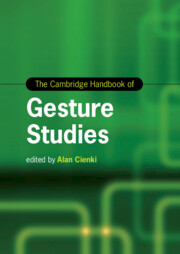Book contents
- The Cambridge Handbook of Gesture Studies
- Cambridge Handbooks in Language and Linguistics
- The Cambridge Handbook of Gesture Studies
- Copyright page
- Contents
- Figures
- Tables
- Contributors
- Introduction
- Part I Gestural Types: Forms and Functions
- Part II Ways of Approaching Gesture Analysis
- Part III Gestures and Language
- Part IV Gestures in Relation to Cognition
- Part V Gestures in Relation to Interaction
- 22 Gesturing for the Addressee
- 23 Gesture and Intersubjectivity
- 24 Variation in Gesture: A Sociocultural Linguistic Perspective
- 25 Communicative Gesturing in Interaction with Robots
- 26 Gestural Interfaces in Human–Computer Interaction
- Index
- References
25 - Communicative Gesturing in Interaction with Robots
from Part V - Gestures in Relation to Interaction
Published online by Cambridge University Press: 01 May 2024
- The Cambridge Handbook of Gesture Studies
- Cambridge Handbooks in Language and Linguistics
- The Cambridge Handbook of Gesture Studies
- Copyright page
- Contents
- Figures
- Tables
- Contributors
- Introduction
- Part I Gestural Types: Forms and Functions
- Part II Ways of Approaching Gesture Analysis
- Part III Gestures and Language
- Part IV Gestures in Relation to Cognition
- Part V Gestures in Relation to Interaction
- 22 Gesturing for the Addressee
- 23 Gesture and Intersubjectivity
- 24 Variation in Gesture: A Sociocultural Linguistic Perspective
- 25 Communicative Gesturing in Interaction with Robots
- 26 Gestural Interfaces in Human–Computer Interaction
- Index
- References
Summary
We explore multimodal communication in robot agents and focus on communicative gesturing as a means to improve naturalness in the human–robot interactions and to create shared context between the user and the robot. We discuss challenges related to accurate timing and acute perception of the partner’s gestures, so as to support appropriate presentation of the message and understanding of the partner’s speech. We also discuss how such conversational behavior can be modelled for a robot agent in context-aware dialogue modelling. The chapter discusses technologies and the building of models for appropriate and adequate gesturing in HRI and presents some experimental research that addresses the challenges. The aim of the research is to gain better understanding of the gesture modality in HRI as well as to explore innovative solutions to improve human well-being and quality of life in the current society. The article draws examples from the AICO corpus which is collected for the purposes of comparative gaze and gesture studies between human–human and human–robot interactions.
Keywords
Information
- Type
- Chapter
- Information
- The Cambridge Handbook of Gesture Studies , pp. 641 - 660Publisher: Cambridge University PressPrint publication year: 2024
